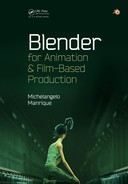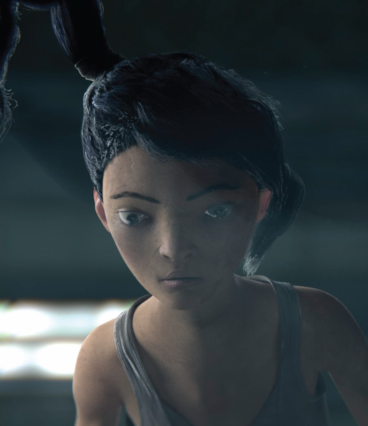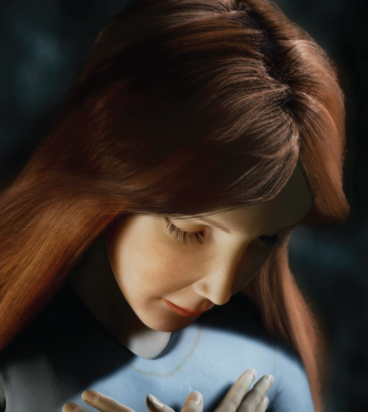Why Blender?
I CONSIDER BLENDER TO be the best 3D content creation suite I have ever used due to several reasons. It's not at the top of my list for sentimental reasons or because it's the only one I have used; it's at the top of my list simply because I feel really comfortable working with it.
You have probably come across a lot of open source and free software. Blender is one of the most popular applications not only in the open source community but also in the 3D content environment, and it has been climbing the list of 3D creation suites in recent years.
If you are interested in open source or free software, check the websites of the Free Software Foundation at http://fsf.org and the Open Source Initiative at http://opensource.org.
Blender has seen a lot of success throughout its history–not just in developing open-source movies but also in building a growing community around it.
But Blender has also had some hardships: refactoring stress, license issues, or the fear of studios introducing Blender in their pipeline.
It is worth comparing Blender supported by a small group of developers, mostly volunteers, with other 3D creation suites supported by a large number of official developers, a big infrastructure, and a lot of money invested in research and development. I want to emphasize that this doesn't mean a better product, but sufficient resources if organized well might end in a better product.
This is also comparable to the perspective on big and small studios. Big studios' films are not necessarily always the better ones or worthy of awards just because they have the infrastructure and funds for research and development (Figures 1.1 and 1.2). Small studios also have a lot of great ideas, but lack infrastructure or funds to put their ideas to work.
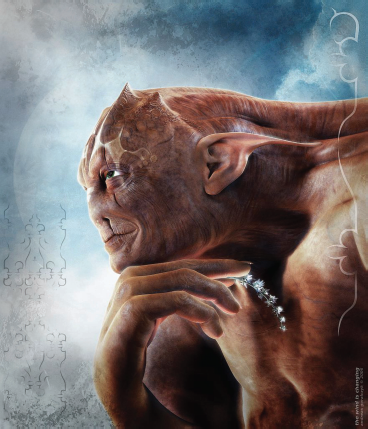
The Wind is Changing by Andy Goralczyk, 2006. Awesome rendering demonstrating how powerful Blender can be in the right hands. This still is an awesome render from 6 years ago. I can assure you that Blender has improved even more in its latest releases, so can you reach the limits?
Blender's workflow and the strong community supporting Blender are probably the two best reasons to use Blender as your main 3D creation suite for small productions or homemade studios.
Is it only suitable for small projects and homemade studios? No, Blender is also suitable for enterprises, big studios, and universities and colleges because it is not only used for 3D films or by artists but also by professionals in varied disciplines like mathematics and science. A search on the Internet would reveal the various kinds of professional institutions that are successfully using Blender on a day-to-day basis, as shown in Figure 1.3.

Contractile Ring simulation by BioBlender. Here, we see how Blender is used in scientific projects.
A good example is the University of Castilla-La Mancha, which has been using Blender in many of its projects thanks to Dr. Carlos Gonzalez Morcillo, Blender Foundation–certified trainer and associate professor of the Department of Technology and Information System at the University of Castilla-La Mancha.
One of the scientific projects developed in Blender is Ganas, a nonlinear animation of characters for sign language representation.
Blender conferences have showcased many projects in the field of science, education, and the like. A lot of interesting, non–3D film related projects are being developed by professionals or amateur artists in a very wide range of activities. Projects like BioBlender, and others developed by the TOSMI (Training in Open-Source Multimedia Instruments) group and for archaeological research do not use the 3D feature of Blender but have turned out to be of quite good quality.
"Blender is for artists" might have been the software's initial goal, but, in fact, Blender has been used in so many different areas that they are the ones that contribute much toward its improvement. A lot of new features are suggested and bugs are reported and fixed.
The results you get with Blender are obviously based on your skills, like in any other application you use or activity you perform. The best thing about Blender is that an amateur can create projects with ease without prior knowledge of the software.
I know that it is hard to believe given Blender's complicated interface and I totally agree that it will look a bit scary for amateurs at the beginning but I'll tell you why this perception is wrong.
Sometime back I read something really interesting in Iker J. de los Mozos' blog, http://somosposmodernos.com. Iker is a great artist and rigger and has worked in very interesting projects, including movies like Planet 51, The Missing Lynx, The Lady and the Reaper, Justin and the Knights of Valour, and Frozen.
I came across some words in his blog that set me thinking about the way we have to approach new software. He basically said that we cannot learn to handle new software correctly if we approach it with preconceived notions.
In other words, we cannot learn and grasp everything that Blender can offer us if we approach Blender software with our knowledge of the Maya software. It's very interesting to start from scratch like a newbie, letting the software surprise us. This will result in a better learning curve than trying to do in Blender what you can do in Maya or any other 3D creation suite.
The Blender interface has been a highly debated topic in computer-generated imagery forums and communities. A whole range of new proposals, changes, and implements are available on the internet but we will be quite mistaken if we approach Blender with any other 3D suite in mind.
We must discard our conventional ideas and approach Blender as total newbies. Ultimately, Blender is not harder to learn than any other application is for people starting from scratch. The problem lies in the fact that people try to find the same things in the same place even when the applications are very different.
As mentioned earlier, the Blender interface has been a very hot topic in various communities and forums. Recently, a study by Andrew Price, http://blenderguru.com, revealed in the Blender Conference 2013 and titled The Big Issues demonstrated popular interest in the Blender user interface.
That study showed that although many people are comfortable with the new interface, a significant number of people totally disagree with it, and are the reason for Blender not being popular.
A couple of clicks, surfing between windows, areas and panels are all you need to navigate through Blender. You can argue that it is this aspect of Blender's user interface that makes you avoid it. I cannot blame you for thinking so because it can be confusing when you use it for the first time, but, believe me, it is not really so hard to understand.
When you get used to Blender's user interface–and you do not need much time for that–the workflow is one of the best as it allows you to develop your project in a comfortable way.
Once you learn to use the basic operators and their keyboard shortcuts, you will enjoy developing new objects, characters, and scenes; applying materials and textures to your models or providing an armature, and animating your characters.
Over the years, I found people giving very different reasons for not using Blender, like it's frustrating using Blender if you don't know the keyboard shortcuts. I will concede that the earlier versions of Blender were difficult but in the recent versions of Blender, the user interface has been simplified to such an extent that this statement is baseless.
It is true that some conventions like the use of left and right mouse buttons can be improved but those shortcomings are like small drops in the ocean.
Blender is powerful and can be effective in animation studios as the main studio creation suite or, in the worst case, as a shared application helping in some specific areas. I will be honest and agree that adopting Blender in a big studio's pipeline could be taking too much of a risk for several reasons but I am confident it will work as well as any other private software as a shared tool (Figures 1.4 and 1.5).

Big Buck Bunny project developed by the Blender Institute. The open movies developed by the BI represent a great example of Blender used for film production.

Tears of Steel is another great example not only for Blender used in animation films but also for vfx projects.
Using Blender as the main tool in very big studios is not only an utopian because, we should be honest, there are a lot of economical interests in adopting one or another creation suite. Ultimately, everything is determined by the market and some applications, as mentioned earlier, expend a lot of human and economical resources to improve their position in the market (Figure 1.6).
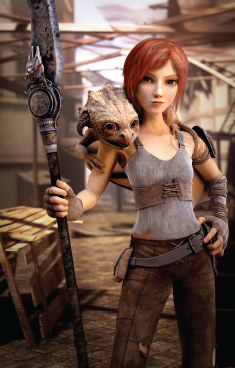
Sintel became a very ambitious project for the Blender Foundation and served as an important test for new awesome features added to Blender's code.
The number and reliability of Blender's features and the variety available makes Blender the perfect application to use. Modular implementations and new features that people propose every day are introduced into Blender's trunk code a feature that others cannot claim they have.
Blender is an open-source software and has one of the biggest and most enthusiastic communities helping in source code development and sharing years of knowledge and experience. A growing number of educational institutions are also supporting it as partners.
Like other applications, Blender is always evolving, and improving its interface even while it is trying to become a really interesting and strong creation suite for artists. In the final analysis, as mentioned earlier, Blender is not only for artists but also for other disciplines such as education, architecture, and science.
The fine quality of the work produced by several artists using Blender is in itself proof that Blender suits artists' needs. Although we cannot claim that Blender is the best ever 3D application in the world, which no other software can also claim to be, we can argue that Blender is one of the most interesting 3D applications in the world with the additional point advantage of being completely free and open to you.
This book focuses on new Blender users but, from my point of view, it could also be interesting for those who are more knowledgeable in the subject, because they could use this book to recollect old stuff learned in the past or to update their current knowledge of recently added features.
I still use Blender's wiki documentation for information on something I am working on, which is not a bad practice at all. It will be futile to try to understand all the features in Blender at one go–in fact nobody should attempt to do so–for manuals and information sources like books are the only way to get all answers to our questions even when we are not connected to the Internet.
This book introduces you to many of these questions. I am sure there are different ways to solve any issue or to complete any Blender exercise successfully, however the solutions I propose in this book are those I have actually used in my homemade studio.
They are not necessarily the best solutions, but they will help you to get reasonably good results in your project. Remember that the purpose of this book is to create a Blender reference to help people manage projects from start to finish, to understand the different stages in any animation production, and to throw some light on how studios work and develop a complete animation project (Figures 1.7 and 1.8).
It will be difficult to provide all these in a single book–there could be something that I might miss–but I will make an honest effort to put down everything that is needed.
In my opinion, this book will help you in the hard task of finding solutions for determined issues avoiding the loss of productive hours searching the net for any specific trouble with your production files or pipeline. We will see some different areas in-depth and others as simple introduction, depending on the purpose of the chapter but I will try to compile as much useful information as you might need.
I assume you are a committed artist and you are probably nervous looking to develop your project as soon as possible. If I have not mentioned it earlier, I will do so right now, be patient because good results require hard work and this takes time.
Read this book to learn how to set up your small home studio and produce a successful project, using Blender and any other open-source application.
Because Blender and other open-source applications are supported and developed mainly by volunteers, they are continuously evolving with new features being added and performance bugs being fixed constantly. At the moment of authoring this book, I am using the Blender 2.2 series, but you will find references to older versions, and sometimes comparison between both, old and modern versions.
Everything you learn in this book will be useful for other 3D applications. In other words, once you learn some basic principles about digital animation you can put them into practice in any other software. Remember, adapting your knowledge to different applications or different versions of the same software makes you valuable in the animation studios' market.
Everything you need is on http://www.blender.org.
